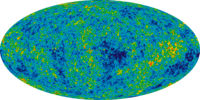
Photo from wikipedia
Laser-induced breakdown spectroscopy (LIBS) is a fast recognition method for heavy-metal detection. The recognition rate of the characteristic spectrum is related to the laser-induced energy. In order to analyze the… Click to show full abstract
Laser-induced breakdown spectroscopy (LIBS) is a fast recognition method for heavy-metal detection. The recognition rate of the characteristic spectrum is related to the laser-induced energy. In order to analyze the polarization characteristics of plasma and the improvement mechanism of recognition rate under the condition of low energy density, a detection model of polarization recognition rate was established by exploring the intensity formula of discrete spectral data. At the Brewster angle, the LIBS and discrete spectral data of Cd and Cu elements induced by five energies were measured in combination with the polarization spectrometric path. According to the model of polarization recognition rate, the optimization effect of the polarization separation approach on the plasma spectra of heavy-metal elements has been clarified, and the recognition rate of discrete spectra induced by low energy density has been improved. This study shows that the increase of laser energy is helpful to the recognition of characteristic spectral lines. Under the same energy induction, the polarization recognition rate of heavy-metal elements is larger, and this characteristic is more obvious under low energy density. This model not only improves the recognition rate of the plasma spectrum but also greatly reduces the requirement of laser energy and the damage of the medium surface, which is a more effective nondestructive testing technology.
Journal Title: Applied optics
Year Published: 2022
Link to full text (if available)
Share on Social Media: Sign Up to like & get
recommendations!